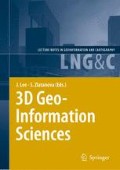Abstract
Using data objects to describe features in the real world is a new idea and several approaches have already been shown to match scientific paradigms exceedingly well [1, 2, 3]. Depending on the required level of abstraction, it is possible to represent the world more or less closely to reality. In the realm of 3D Geoinformation research, this realism is often related to the way the spatial world is represented. By contrast, the 2D GIS community focuses on attribute data that describes additional states or characteristics of a feature. The main focus in 3D Geoinformation has always been on the representation of spatial objects, on relations like topology, ontology, and on storing and presenting them with more or less detail. The Centre for 3D GeoInformation (3DGI) at Aalborg University is currently participating in a project that explores objects that will not only contain geometry and associated attributive data but also will contain behavioural information. Our goal is to communicate the design and handling of these enhanced objects by means of the concept introduced in Java whereby objects are created in bytecode and subsequently executed within a Java virtual machine. This concept has already been implemented in the GRIFINOR (http://www.grifinor.net) platform [4]. This article will present the core ideas of relevance to this concept as it relates to current understanding of objects. Our work also offers suggestions on how to implemented such algorithms using real-life infrastructure data. Furthermore, we elaborate on the possibilities and challenges associated with moving from mostly static objects to dynamic objects in the area of 3D geoinformation.
Access this chapter
Tax calculation will be finalised at checkout
Purchases are for personal use only
Preview
Unable to display preview. Download preview PDF.
References
Chance, A., Newell, R. & Theriault, D. (1990) An Object-Oriented GIS - Issues and Solutions. EGIS ‘90. Amsterdam, The Netherlands, EGIS Foundation.
Vckovski, A. (1998) Interoperable and Distributed Processing in GIS, London, Taylor & Francis.
Egenhofer, M. J. & Frank, A. U. (1992) Object-oriented modeling for GIS. URISA Journal, 4, 3-19.
Bodum, L., Kjems, E., Kolar, J., IlsØe, P. M. & Overby, J. (2005) Grifinor: Integrated Object-Oriented Solution for Navigating Real-time 3D Virtual Environments. IN Oosterom, P. V., Zlatanova, S. & Fendel, E. M. (Eds.) Geo-information for Disaster Management. Berlin, Springer Verlag.
Kjems, E. & Kolar, J. (2005) From mapping to virtual geography. IN Batty, S. E. (Ed.) CUPUM ‘05: Computers in Urban Planning and Urban Management: Abstracts of the 9th International Conference. London, Centre for Advanced Spatial Analysis, University College London.
Kolar, J. (2006) Global Indexing of Topographic Surface for 3D Visualization and Analysis. Ph.D. thesis, Centre for 3D GeoInformation - Department of Development and Planning. Aalborg, Aalborg University.
Pilouk, M. (1996) Integrated Modelling for 3D GIS. Wageningen Agricultural University and ITC, The Netherlands.
Stoter, J. & Zlatanova, S. (2003) Visualisation and editing of 3D objects organised in a DBMS. In Woodford, P. (Ed.) EuroSDR comm. 5 workshop on Visualisation and Rendering. ITC, Netherlands, EuroSDR.
Kolar, J. (2007) Managed Code Interoperability In Digital Earth Technology. Proceedings of the 5th International Symposium on Digital Earth, University of Berkeley, CA, USA.
Author information
Authors and Affiliations
Editor information
Editors and Affiliations
Rights and permissions
Copyright information
© 2009 Springer-Verlag Berlin Heidelberg
About this chapter
Cite this chapter
Kjems, E., Bodum, L., Kolar, J. (2009). Managed Objects for Infrastructure Data. In: Lee, J., Zlatanova, S. (eds) 3D Geo-Information Sciences. Lecture Notes in Geoinformation and Cartography. Springer, Berlin, Heidelberg. https://doi.org/10.1007/978-3-540-87395-2_7
Download citation
DOI: https://doi.org/10.1007/978-3-540-87395-2_7
Publisher Name: Springer, Berlin, Heidelberg
Print ISBN: 978-3-540-87394-5
Online ISBN: 978-3-540-87395-2
eBook Packages: Earth and Environmental ScienceEarth and Environmental Science (R0)

